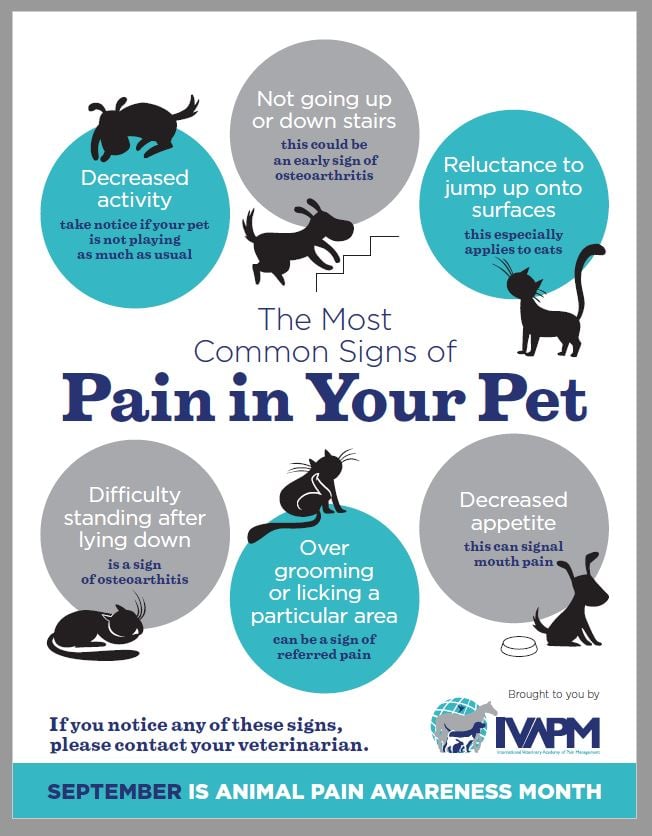September is Animal Pain Awareness Month. The International Veterinary Academy of Pain Management (IVAPM) works to raise awareness and create greater understanding for our animals suffering with pain. Just as in humans, there is silent suffering of different ailments that might cause pain.
Let’s examine all you need to know about signs of pain in your pets, sources of pain as well as treatments for pet pain.
How do I know my Dog is in Pain?
An overall statement for whether your pet might be in pain is are you noticing their usual behaviors are changing? If so, try to reflect upon what the change is and identify what might be the source of pain. According to the IVAPM, here are the 6 most common signs of pain in your pet:
- Decreased activity
- Not going up and downstairs
- Reluctance to jump on surfaces (or furniture)
- Difficulty standing after lying down
- Over-grooming or licking
- Decreased appetite
Trust your instincts. If you notice that your dog “always” does something and then is doing something quite different, there may be a problem. If you are reviewing these symptoms and you decide that indeed, your dog’s behavior has changed enough and you are concerned, contact your veterinarian.
Here’s a resource from IVAPM that makes the top 6 common signs of pain understandable visually:
Additional signs of pain:
There are also some underlying characteristics associated with pain that alter the behaviour of a pet. This includes:
- Aggressive behaviour
- Being anti-social
- Easily aggravated
- Heavy panting
- Shaking or trembling
Obvious mobility issues
Is your dog limping more or showing signs of stiffness? Are you noticing they are not wanting to jump up on the furniture? If you see something as if they are walking with a paw up, they may have an injury or something in their paw that is irritated. However, if they are moving less and not as active as they once were, they may be experiencing the painful signs of arthritis.
Arthritis is a common health problem. It is also one of the most overlooked health problems. This is because often, we begin to offer excuses on why our pets have slowed down. We believe they are simply getting older when really our pets are starting to feel the signs of arthritis just as in adults.
Arthritis in Dogs
Osteoarthritis (OA) or arthritis, is a joint disease affecting people, as well as dogs. It is as painful for our fur-babies as it is for us. In healthy joints, a slippery tissue called cartilage cushions the ends of the bones in the joints. When arthritis is present, cartilage breaks down, causing pain and swelling. As it gets worse, bone spurs can form, causing more pain and joint damage.
Often, this is dismissed as simply "getting older." However, there are some very real issues with arthritis. And, just as there are things you can do for people, pets have options too.
There is also a short quiz you can take to assess your dog for signs of arthritis:
Treatments for Pain
Here is an article clarifying the difference between pain treatments there are for your dog. For a refresher, here’s what to know about treating your dog in pain. Know about NSAIDs and supplements for pain as well as reasons why over-the-counter pain relievers may be good for us, but not our pets. Read more here.
GLYDE™ MOBILITY CHEWS
Parnell Living Science, the makers of Glyde Mobility Chews, are experts in arthritis in dogs. We created a unique formula with key ingredients to combat the signs of aging. Glyde uses natural, gluten-free ingredients to promote healthy joints to let your dog do everything he or she loves to do! Glyde is the only joint supplement that contains proven levels of three key components that work together to relieve the painful signs of arthritis.
Glyde's proven formula has all-natural ingredients and high levels of glucosamine and chondroitin, plus Green Lipped Mussel (GLM). The proven levels of these key ingredients are what makes the formula unique:
- New Zealand Green Lipped Mussel (GLM): A powerful anti-inflammatory
- Glucosamine: Reduces cartilage degradation
- Chondroitin Sulfate: Helps rebuild cartilage
There are many choices out there. Research and try what you need for your fur-baby! Just like people, every dog is different.
As we reflect on September's Pain Awareness Month, keep in mind your dog and how they have changed over the years. If you are starting to see them slowing down, consider Glyde® Mobility Chews.
No matter what works for you and your dog, let's be sure to keep them happy and healthy. Remember they can't tell you if they are hurting. Assess their behavior regularly so you know if the pain is an issue. As always, with regular check-up with your veterinarian, keep them posted on how they are doing as they age. Because we all agree: dogs are part of the family! Let's keep them happy and healthy as long as we can!
















